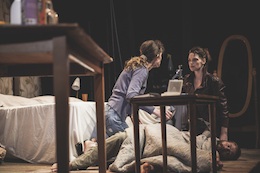BrokenCrow theatre company are making their mark with a decent new production that gets right under the skin of an interesting American play. It is probably a compliment to say that the experience of watching Bug gets itchier as it goes on.
Tracy Letts’s play offers its own perspective on a territory heavily mined by Sam Shepard where that ubiquitous American space – a motel room – expands as old American Western tropes like the cowboy drifter do battle with some contemporary ills. In Bug the pervasive sense of surveillance looms against a background of some sinister incarcerations.
 As the manic sense of such things spirals in the course of the two-act play, something monstrously implausible becomes disturbingly poetic. In fact the play is reminiscent of a very early Shepard play, Red Cross, where a man and a woman in a completely white room feel that they are being infested by crabs. In Shepard’s play the characters end up floating into a kind of dream-state. While Letts owes something to Shepard in terms of the feel of the piece and the particulars of the setting, this work by Letts is a more interesting and satisfying piece.
As the manic sense of such things spirals in the course of the two-act play, something monstrously implausible becomes disturbingly poetic. In fact the play is reminiscent of a very early Shepard play, Red Cross, where a man and a woman in a completely white room feel that they are being infested by crabs. In Shepard’s play the characters end up floating into a kind of dream-state. While Letts owes something to Shepard in terms of the feel of the piece and the particulars of the setting, this work by Letts is a more interesting and satisfying piece.
What begins as an off-kilter love story evolves into a paranoid drama where the guy believes that his body is being invaded by bugs and that this is some kind of shadowy CIA conspiracy that started when he was plucked from the army for torturous medical experiments. There is a nice bit of flip-flopping between the notions of paranoia and real conspiracy that is never fully resolved.
With posters around Cork city, BrokenCrow make their bid for a particular theatre-going constituency with close-up images of bugs burrowing into the bleeding skin of the main two characters. Carl Kennedy’s sound design kicks in with lively sense of the manifesto. It attacks our sensibilities with crunching static electricity and heavy bass booming from the room before echoing later to the alternating sounds of a spookily distant hotel bar, low flying helicopters, hissing air-conditioning and the drawl of Hank Williams. Lest we draw comfort from the lighting, Eoin Winning’s design ensures that the space is always bathed in the colour of urine. So far, so unhomely.
George Hanover as Agnes walks across the floor of this seedy Oklahoma motel room, lights a pipe, snorts some powder and takes a phone call from someone who doesn’t speak. Hanover’s central performance gives a very strong and credible sense of a life that is wasted, damaged and left to stagger along with fragility. It is a role that she inhabits rather than wears.
Agnes has a moment where she looks at a painting on the wall of Deirdre Dwyer’s set. The painting in washed out colours is of a small swimming pool with a couple of palm trees. It is a parody of a vision of splendour. Agnes has grown to like it and looks fondly at it, in a moment that tells us there is no future for her in any real sense. Dwyer’s set has all the requisite filth but, like the play itself, the wallpaper columns instead of walls reach beyond the naturalistic into something vaguely symbolic.
.jpg.aspx%3Fwidth=260&height=173) Chris Schmidt-Martin catches the peculiar gentleness, anger and paranoia that define the character of Peter Evens, who wanders into the life of Agnes with his own needs and his own equivocal love. He works nicely from remoteness to free-flowing dementia.
Chris Schmidt-Martin catches the peculiar gentleness, anger and paranoia that define the character of Peter Evens, who wanders into the life of Agnes with his own needs and his own equivocal love. He works nicely from remoteness to free-flowing dementia.
Both actors grow into the craziness of their roles as the play becomes more compelling and disturbing in the final part.
Jon Whitty is well cast as Dr Sweet who may be there to help or possibly to bring your life to a painful end. Eadaoin O’Donoghue seems to float through the piece in an oddly wistful way as R.C. Mark D’Aughton’s voice seems far too plummy to carry a real sense of Jerry Goss just having been released from jail. His is a key role and the play would have worked better with a keener sense of his character prowling the room like a caged animal ready to shred every living creature in sight.
Accent is a more general problem in the production. It doesn’t prevent the characters from coming through but the Cork lilt is at times so jarring it blows the sense of place out of the water, particularly when the script and BrokenCrow’s own production is so evocative of a very particular kind of place. Director Frank Prendergast’s unhurried pace lets the spookiness of the script seep through and in the two central performances he has encouraged performances of significant depth.
BrokenCrow are making their voices heard with their generally impressive take on what is a kind of Stepford Wives on acid.
Liam Heylin’s plays include Gdirl from Gdansk and Love, Peace & Robbery. He works as a journalist for the Irish Examiner.